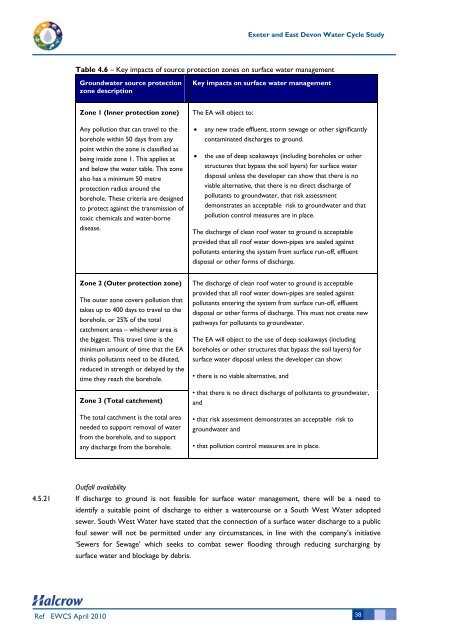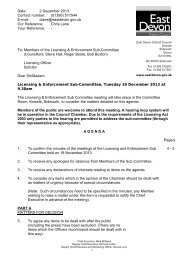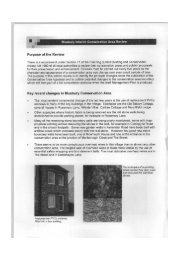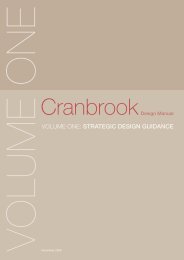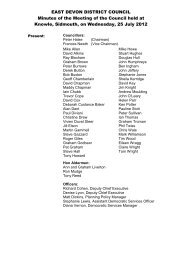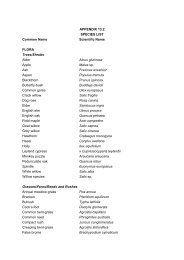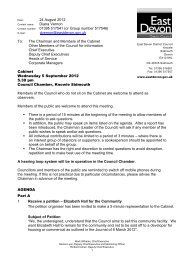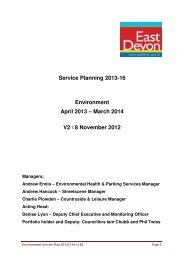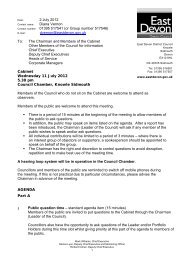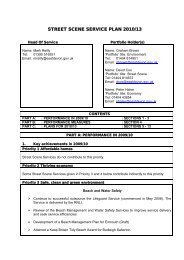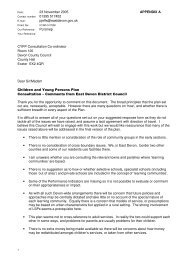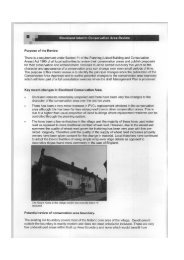Water Cycle Study - East Devon District Council
Water Cycle Study - East Devon District Council
Water Cycle Study - East Devon District Council
Create successful ePaper yourself
Turn your PDF publications into a flip-book with our unique Google optimized e-Paper software.
Ref EWCS April 2010<br />
Exeter and <strong>East</strong> <strong>Devon</strong> <strong>Water</strong> <strong>Cycle</strong> <strong>Study</strong><br />
Table 4.6 – Key impacts of source protection zones on surface water management<br />
Groundwater source protection<br />
zone description<br />
Zone 1 (Inner protection zone)<br />
Any pollution that can travel to the<br />
borehole within 50 days from any<br />
point within the zone is classified as<br />
being inside zone 1. This applies at<br />
and below the water table. This zone<br />
also has a minimum 50 metre<br />
protection radius around the<br />
borehole. These criteria are designed<br />
to protect against the transmission of<br />
toxic chemicals and water-borne<br />
disease.<br />
Zone 2 (Outer protection zone)<br />
The outer zone covers pollution that<br />
takes up to 400 days to travel to the<br />
borehole, or 25% of the total<br />
catchment area – whichever area is<br />
the biggest. This travel time is the<br />
minimum amount of time that the EA<br />
thinks pollutants need to be diluted,<br />
reduced in strength or delayed by the<br />
time they reach the borehole.<br />
Zone 3 (Total catchment)<br />
The total catchment is the total area<br />
needed to support removal of water<br />
from the borehole, and to support<br />
any discharge from the borehole.<br />
Key impacts on surface water management<br />
The EA will object to:<br />
• any new trade effluent, storm sewage or other significantly<br />
contaminated discharges to ground.<br />
• the use of deep soakaways (including boreholes or other<br />
structures that bypass the soil layers) for surface water<br />
disposal unless the developer can show that there is no<br />
viable alternative, that there is no direct discharge of<br />
pollutants to groundwater, that risk assessment<br />
demonstrates an acceptable risk to groundwater and that<br />
pollution control measures are in place.<br />
The discharge of clean roof water to ground is acceptable<br />
provided that all roof water down-pipes are sealed against<br />
pollutants entering the system from surface run-off, effluent<br />
disposal or other forms of discharge.<br />
The discharge of clean roof water to ground is acceptable<br />
provided that all roof water down-pipes are sealed against<br />
pollutants entering the system from surface run-off, effluent<br />
disposal or other forms of discharge. This must not create new<br />
pathways for pollutants to groundwater.<br />
The EA will object to the use of deep soakaways (including<br />
boreholes or other structures that bypass the soil layers) for<br />
surface water disposal unless the developer can show:<br />
• there is no viable alternative, and<br />
• that there is no direct discharge of pollutants to groundwater,<br />
and<br />
• that risk assessment demonstrates an acceptable risk to<br />
groundwater and<br />
• that pollution control measures are in place.<br />
Outfall availability<br />
4.5.21 If discharge to ground is not feasible for surface water management, there will be a need to<br />
identify a suitable point of discharge to either a watercourse or a South West <strong>Water</strong> adopted<br />
sewer. South West <strong>Water</strong> have stated that the connection of a surface water discharge to a public<br />
foul sewer will not be permitted under any circumstances, in line with the company’s initiative<br />
‘Sewers for Sewage’ which seeks to combat sewer flooding through reducing surcharging by<br />
surface water and blockage by debris.<br />
38


